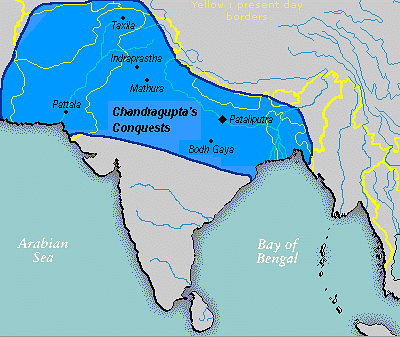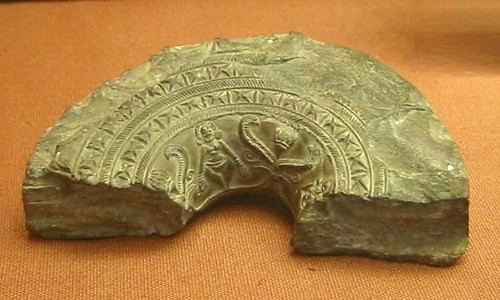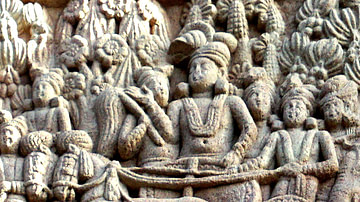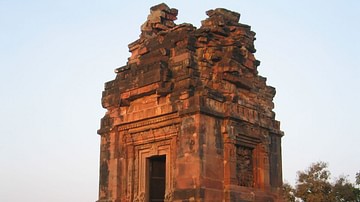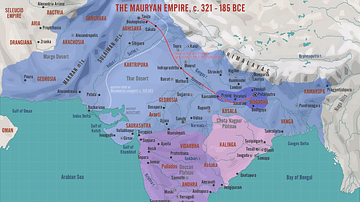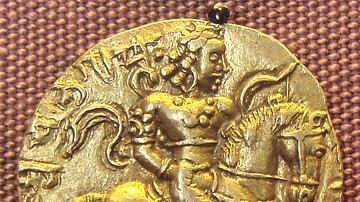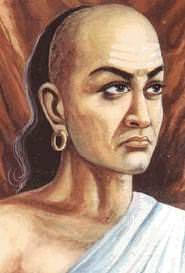
Chanakya (l. c. 350-275 BCE, also known as Kautilya and Vishnugupta) was prime minister under the reign of Chandragupta Maurya (r. c. 321-c.297 BCE), founder of the Mauryan Empire (322-185 BCE). He is best known as the author of the political treatise Arthashastra which he wrote as an instruction manual for the young Chandragupta on how to rule effectively.
The events of his life are known only through legends from various traditions; no historical documents have survived concerning him or his role in the establishment of the Mauryan Empire. According to one tradition, he served as advisor to the last king of the Nanda Dynasty (c. 5th century -322 BCE) Dhanananda (also given as Dhana Nanda, r. 329-322/321 BCE) who ruled the Kingdom of Magadha. According to another, he was a Vedic scholar from the university of Taxila who visited the court of Dhanananda where he was insulted at an alms-giving ceremony and, after this event, devoted himself to deposing the king.
He first attempted to enlist the king's son, Pabbata, in his cause and is also said to have approached others before narrowing his most likely candidates down to Pabbata and a young man who was either a lesser member of the noble house or a commoner, Chandragupta. After testing the two youths, Chandragupta proved the most resourceful and Chanakya focused his efforts on training the future king for the next seven-to-nine years. When his training was completed, Chandragupta overthrew Dhanananda and assumed control of Magadha.
The Arthashastra is considered Chanakya's training manual by which he transformed Chandragupta from a citizen to a monarch. The precepts of the Arthashastra not only enabled Chandragupta to seize power but to maintain it, passing it down to his son, Bindusara (r. 297-c.273 BCE) and then to his grandson Ashoka the Great (r. 268-232 BCE) whose initial success can also be attributed to the Arthashastra until he grew disillusioned by war and converted to Buddhism. The Arthashastra is informed by the philosophical school of Charvaka (developed c. 600 BCE) which rejected the supernatural explanation of phenomena in favor of a completely materialistic world view. The practical, hands-on, nature of the Arthashastra most likely could never have developed without the foundation of Charvaka to build on.
The Arthashastra continued to exert considerable influence after the reign of Ashoka but then disappeared and was considered lost until it was discovered in 1905 CE by the Sanskrit scholar Rudrapatna Shamasastry (l. 1868-1944 CE). Shamasastry published the work in 1909 CE and then translated it into English and published that version in 1915 CE which brought it greater attention.
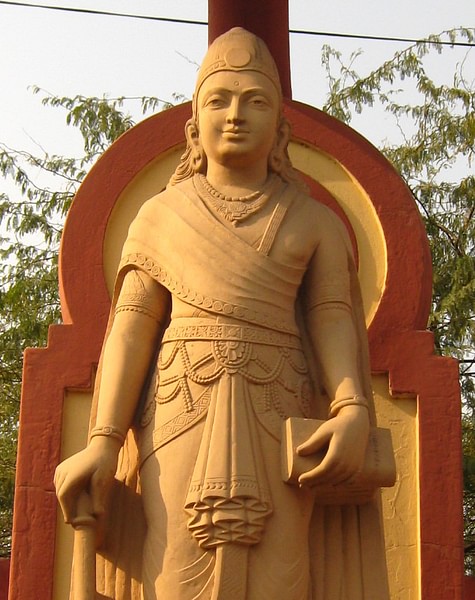
Since that time, the work has continued to be studied as one of the greatest pieces of political science ever written, frequently compared to The Prince by Niccolò Machiavelli (1469-1527 CE) whose treatise on how a Renaissance prince should comport himself became as influential in European political science as the Arthashastra was in India over 1500 years earlier. The central message of The Prince – that a true leader is one who sees what needs to be done and is able to do it, regardless of so-called morals – informs the Arthashastra as well. It has also been compared with Plato's Republic and Sun Tzu's The Art of War as a manual for establishing and maintaining a strong State.
Early Life & Revolt
There are no agreed-upon historical texts relating to Chanakya's life and work. Some scholars, in fact, have even challenged his authorship of the Arthashastra. Information on Chanakya's life, his role in the elevation of Chandragupta, and the creation of the Arthashastra come from legends which the scholar Thomas R. Trautmann has identified as:
- Buddhist Tradition – the text of the Mahavamsa
- Jain Tradition – the text of the Parishistaparvan
- Kashmiri Tradition – the text of the Kathasaritsagara
- Vishakhadatta's version – his play Mudrarakshasa
Of these, the Buddhist tradition is the earliest, but its content is developed by the later works which add or omit various details. The basic story, according to the Buddhist tradition, presents Chanakya as a Brahmin scholar from the university at Taxila who arrived at the court of Dhanananda for an alms-giving ceremony. Chanakya (in every version of his legend) had “canine teeth” which folk superstition interpreted as a sign of royalty. When he was a young man, his mother mourned the fact that he was destined to rule and would forget about her once he had become king. In order to allay her fears, he broke his teeth and was afterwards regarded as disfigured. He also seems to have been lame and, generally, of poor appearance.
He arrived at the ceremony and was waiting with the others when Dhanananda entered and insulted him, calling attention to his looks and demanding he be removed from the assembly. Chanakya cursed the king, who ordered his arrest, and then escaped to the surrounding forest where he plotted his revenge. He is said to have known of a method of multiplying wealth whereby he could turn one coin into eight. In the woods, he implemented this mysterious technique to create the hoard of gold coins he would require for an army to overthrow Dhanananda; what he lacked, however, was a man he could mold into a leader who would take Dhanananda's place.
Chanakya & Chandragupta
His first choice seems to have been Dhanananda's son Pabbata, though the boy could have been only one of many he considered, and then the youth Chandragupta. According to some versions of the story, Chandragupta was also of the Nanda family but not the royal line. In other versions, he was a commoner whose family had once been affluent but now were farmers who raised peacocks. Patel recognizes this latter version as legitimate, writing:
After being insulted and thrown out, Chanakya goes and finds a ten-year-old orphan farmhand called Chandragupta, and nine years later turns him into the first emperor of the largest Empire the region had ever seen. Not for nothing is it said that truth is stranger than fiction. (7)
Whichever version is true does not finally matter because, in both, Chanakya transforms the young man into a powerful king. Before this could happen, however, he had to be sure of the characters of the boys whose destinies he was about to change. After he had narrowed his choices down to two, he gave Pabbata and Chandragupta each an amulet on a woolen thread which they were to wear closely around their necks. One day, when Chandragupta was sleeping, Chanakya told Pabbata to go to his room and remove the amulet without breaking the thread.
Pabbata returned empty-handed and admitted he had failed. Chanakya then required the same of Chandragupta on another day when Pabbata was sleeping. Chandragupta cut off Pabbata's head and returned to his master carrying the amulet. Chanakya had found his future king in that, by taking the most drastic and direct action in accomplishing the task, Chandragupta had proven himself capable of rule in recognizing what had to be done and being able to do it.
Political Landscape & Rise to Power
The region at this time was comprised of small kingdoms and tribes dominated by the Nanda Empire of the Kingdom of Magadha under Dhanananda but had been destabilized by the invasion of Alexander the Great in 326 BCE. Following the Battle of the Hydaspes River between Alexander and King Porus of Paurava (r. c. 326-315 BCE), Porus is alleged to have told Alexander he could easily topple the Nanda Empire because Dhanananda was so unpopular with the people and they would support his campaign.
According to the later Roman historian Curtius (l. 1st century CE), Alexander's men knew Dhanananda as Xandrames or Agrammes, a mighty king who could easily field 200,000 infantry and 20,00 cavalry in addition to chariot units and war elephants. Alexander's army had already endured great hardships following their general to India and now refused to go up against an army which was considered invincible. They threatened mutiny and forced Alexander to abandon his campaign and return to Mesopotamia.
According to legend, Chandragupta met Alexander at this time and requested leave to serve in his army. According to Plutarch (l. c. 46-120 CE), the meeting did not go well, and Chandragupta fled from Alexander's camp in fear for his life. Although this might be possible, it is more likely that, with Chanakya's encouragement, Chandragupta offered his services to Dhanananda and possibly served in his army in order to gain military experience.
Chanakya is said to have spent between seven and nine years training Chandragupta, lessons which had to have included some form of military service, and then directed his protégé to the north-west region of India which Alexander's army had destabilized before leaving. Chandragupta easily defeated the small kingdoms and the tribes which had already been beaten by Alexander and established a base from which to launch his assault on Magadha. Chanakya assisted in the preparation for the attack through intrigue, spies, and political manipulation to weaken the opponent while gathering intelligence on his strengths. Chandragupta failed in his first attempt but, in 321 BCE, deposed and killed Dhanananda and assumed power.
Charvaka & the Arthashastra
Once Chandragupta was installed as king, Chanakya became his prime minister. He may have composed the Arthashastra shortly afterwards but any claim regarding a specific date of composition is speculative. What is clear, however, is that the work could not have been written were it not for the philosophical school of Charvaka which established the kind of intellectual landscape which allowed for it.
Charvaka rejected religious interpretations of existence in favor of materialism, stating its vision through six main tenets:
- Direct perception as the only means of establishing and accepting any truth
- What cannot be perceived and understood by the senses does not exist
- All that exists are the observable elements of air, earth, fire, and water
- The ultimate good in life is pleasure; the only evil is pain
- Pursuing pleasure and avoiding pain is the sole purpose of human existence
- Religion is an invention of the strong and clever who prey on the weak
The founder is thought to have been a reformer named Brhaspati (l. c. 600 BCE) who seems to have objected to the power of the priestly class and the hold they had over the people, especially the lower classes. He is said to have composed a text on his philosophy, the Brhaspati Sutra, which has long been lost and all that is known of the philosophy comes from later Hindu, Jain, and Buddhist texts which refute Brhaspati's claims.
Charvaka completely rejected the Hindu religious texts known as the Vedas which were believed by the orthodox to be the words of Brahman, creator of the universe and the Universe itself. Religious and philosophical schools which accepted the Vedas were known as astika (“there exists”) while those who rejected the Vedic vision were known as nastika (“there does not exist”). Jainism and Buddhism are both considered nastika schools of thought but Charvaka, also nastika, took the concept further to deny any supernatural existence or authority whatsoever.
Although it never became a widely accepted school of thought, Charvaka offered the possibility of seeing the world in a non-religious, completely pragmatic, light. This new vision would allow for works like the Arthashastra, which blends astika and nastika schools of thought, to be written. Scholar P. Ram Manohar comments:
The fact that the Astika school of thought dominated in India led to the emergence of a knowledge system that was predominantly spiritual in outlook, although this was supplemented with a scientific approach to understanding the mundane world. Amongst the Nastika schools, Buddhism and Jainism were well-codified and developed into organized establishments. It is pertinent to note that the Charvaka school…never became established as a predominant school of thought…But the Charvaka system of thought exerted a powerful influence and helped to achieve a balance between the spiritual and material worldviews. The Charvaka school ensured that the materialistic perspective found a legitimate place in the canvas depicting reality. (Paranjape, 5)
Materialism informs the Arthashastra in its focus on the here-and-now and how a king must sometimes make what appear to be difficult choices in order to rule effectively. The concepts the Arthashastra explores were certainly in use prior to Chandragupta's reign as they seem to have been integral to his success and most likely developed through a blending of astika and nastika thought. The precepts of Chanakya are all eminently practical while also acknowledging the existence of a higher power who approves of the king's necessary actions as his dharma (duty) which must be performed in accordance with his karma (action). Patel breaks the Arthashastra into seven broad categories all focusing on a king's success in foreign and domestic policy and what courses a monarch should be able and willing to pursue:
- Strategy. Chanakya's focus is on stable rule and relations with neighboring states. Much of the book is devoted to political, military, and secret strategy.
- Subterfuge. When classic or open strategy fails, there are always what Chanakya refers to as `secret means'. Chanakya discusses poisons and instigated riots in the same way as he discusses the measurements for forts.
- Spies. There is a great deal in this book about spies, from courtiers to wandering lunatics. It is important to understand that Chanakya uses spies as information gatherers. In another era, there would be other ways of doing this; at the time of writing, salting spies throughout your culture was the only reliable way of knowing what was happening anywhere.
- Bureaucracy and Fines. An extensive part of the original document details the structure of government buildings and rules in minute detail, as well as specific offenses and fines, both civil and criminal.
- Protection. A ruler of any kind must be conscious of attacks, both against their person and against their position or kingdom.
- Verification. How do you know who you can trust? This is one of the central questions of governance and one that Chanakya devotes significant time to.
- Attack. How does one attack an enemy so that long term problems are avoided? How can one attack a stronger enemy or ascertain their real intention? (8-9)
These topics, and many others, are covered in the 15 books which make up the treatise of the Arthashastra. Chanakya guided Chandragupta's reign by these precepts and, in so doing, created one of the greatest and most powerful empires of the ancient world.
Conclusion
Chanakya served his king until Chandragupta converted to Jainism and abdicated in favor of his son, Bindusara. According to legend, the king then retired to the forest to become a religious ascetic and died through ritual fasting. Chanakya, after ensuring that Bindusara's reign was stable, left him with the Arthashastra as a guide and is said to have also retired to the forest; after he leaves the Maurya court, according to all versions of his legend, nothing more is known of him.
Chanakya's work has sparked as much controversy over its morality – or the lack of it – as Machiavelli's The Prince. Chanakya can be seen as a soulless materialist who uses whatever is to his advantage to achieve his ends, or as an enlightened pragmatist who recognizes that one must sometimes engage in distasteful acts in order to achieve noble ends. It cannot be denied that the precepts of the Arthashastra enabled the founding and maintenance of the Mauryan Empire which superseded any in the region previously and this must be regarded as a positive, as Patel notes:
The influence of the Mauryan empire cannot be overstated in Indian history. It was the largest empire of all time and introduced the world to Buddhism. It created a stable political structure that, though it changed hands over time, more often than not led to a continuous lineage of thought and development. (13)
Whether seen as a hero or villain, Chanakya's influence and his Arthashastra made the Mauryan Empire possible but, at the same time, the work advocates for disregarding moral considerations in favor of practicality and expediency. The Arthashastra continues to engage students of politics, religion, and philosophy in examination of this central problem which its concepts and influence present: can a positive result be regarded as objectively good if it is attained by negative means? Chanakya would no doubt answer in the affirmative but scholars who study his work seem inclined to stipulate, qualify, or even stop before fully agreeing with his vision.
